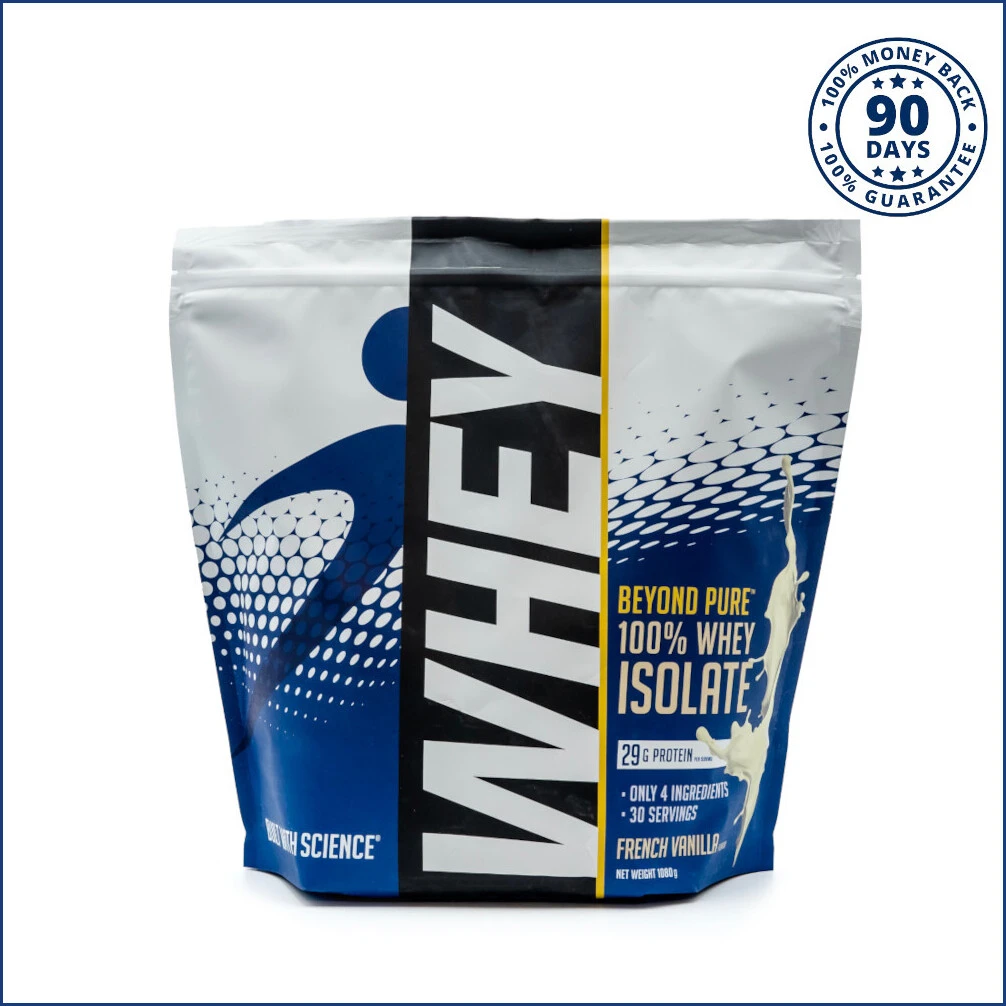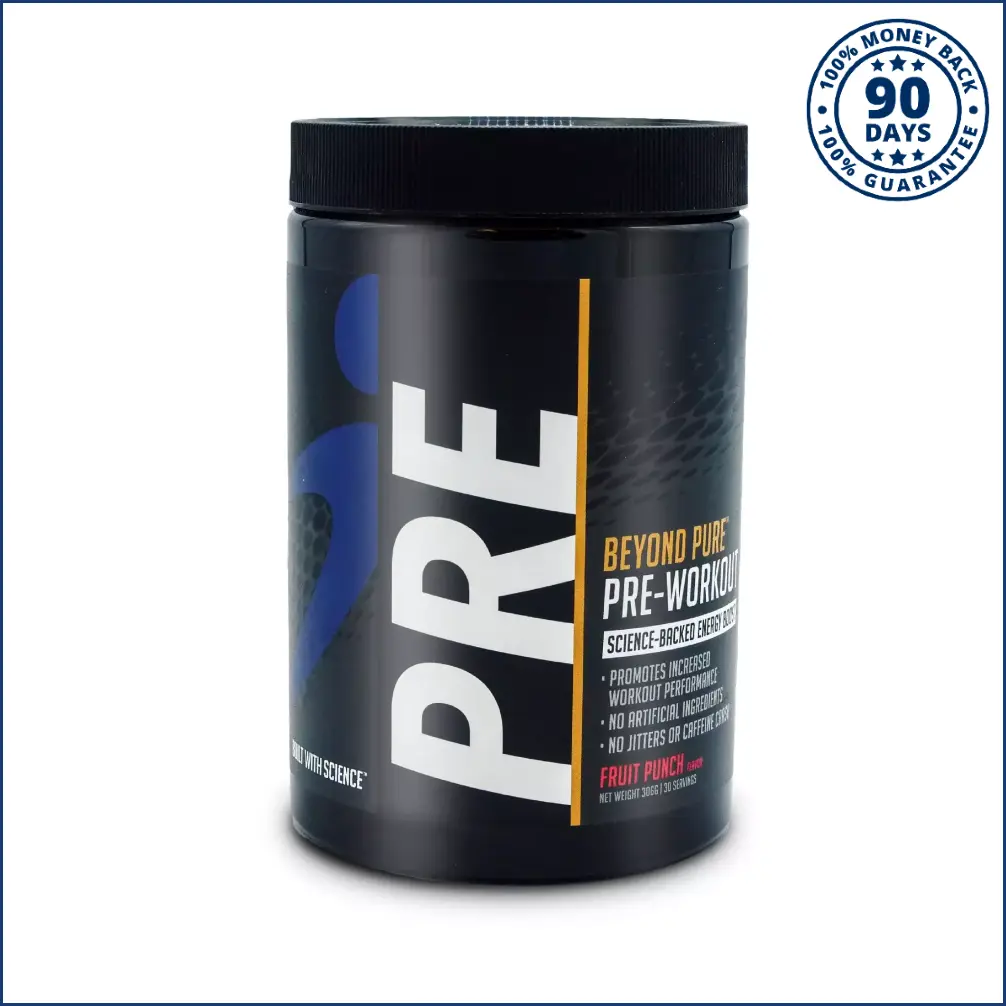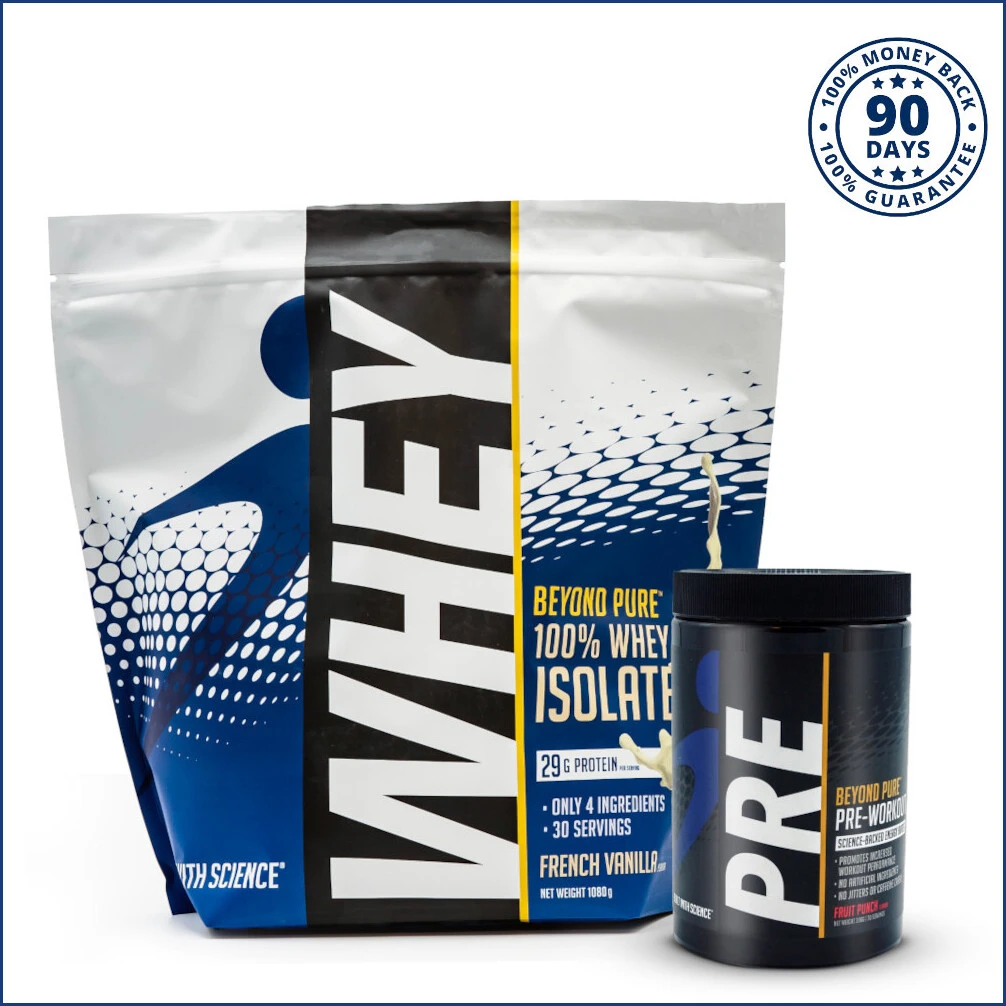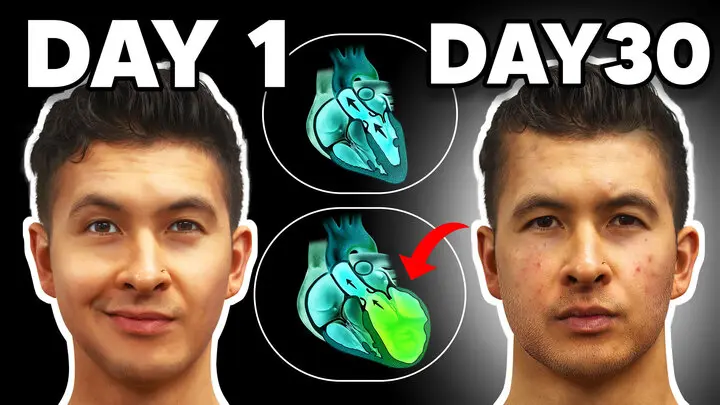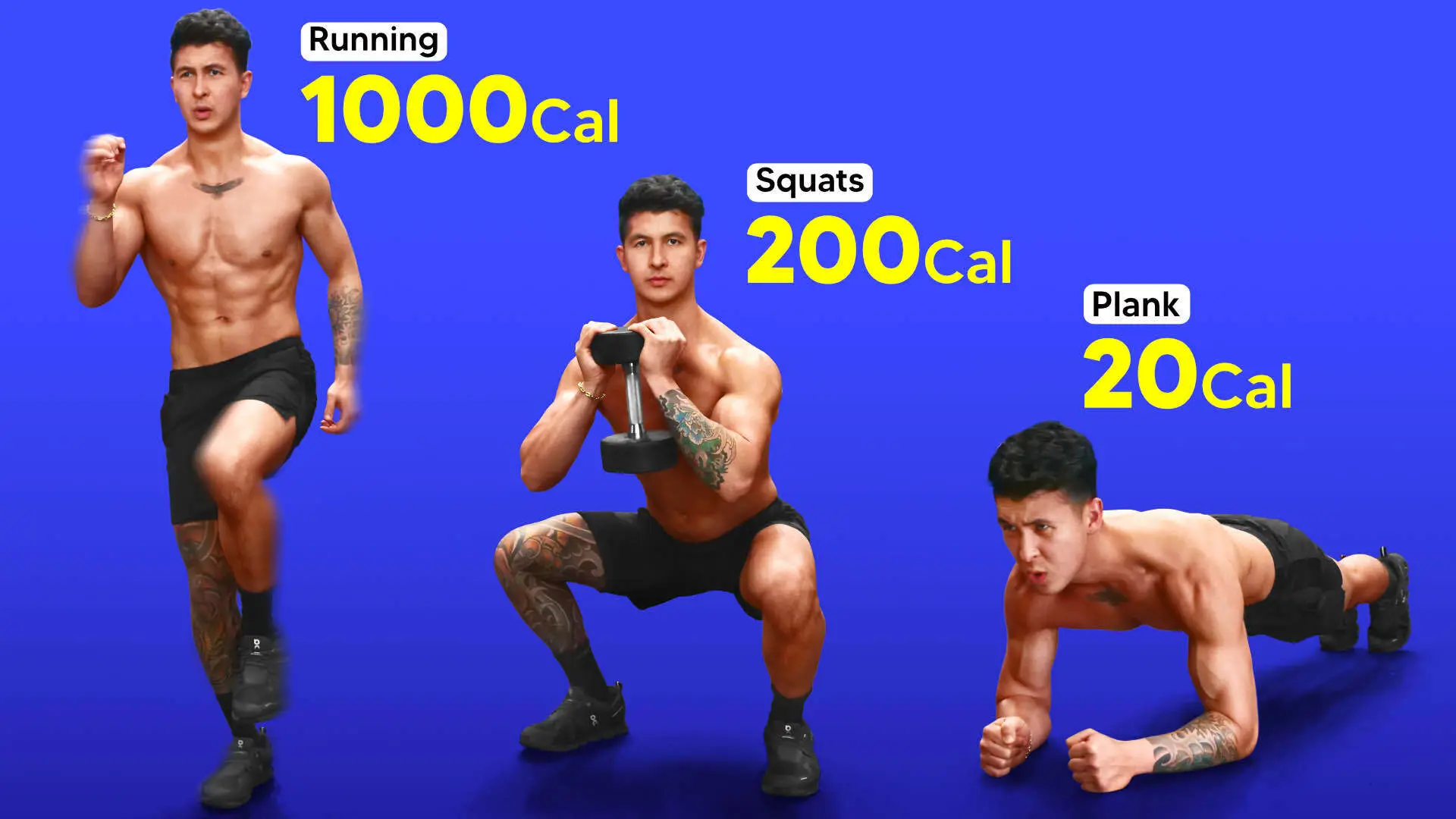
What Are The Best Fat Loss Exercises? (I Studied 50)
What are the best fat loss exercises? Worst? Find out in this article.
Today my friend Kevin and I are using the world’s most accurate calorie tracker to rank 50 different exercises and find out which are the best fat loss exercises.
At the end, we’ll reveal one as the all time highest calorie burner.
But we’ll also discover which exercises burn the most calories with minimal effort and which ones are high-effort but don’t actually burn very many calories.
Using these findings, I’ll create the perfect fat loss plan guaranteed to help you shred body fat.
High-Intensity Fat Loss Exercises
So once we had our masks on we headed out for our first test.
Starting out with what all the data told me was the most powerful for calorie burning, high intensity training, beginning first with 60 seconds of sprinting.
Sprinting
Because the workouts are so intense, Kevin was already starting to feel it before the 60 seconds were finished.
By The Way, Meet Kevin
In case you’re wondering, Kevin is a programmer here at Built With Science and he’s currently been working on his own fat loss journey. And my hope is that doing these workouts together will help me get the data I need to help Kevin to maximize his weight loss journey.

Burpees And Mountain Climbers
We then ran through a 60 second circuit of Burpees and 60 seconds of Mountain Climbers, and just like with the sprint, Kevin was struggling to make it the full 60 seconds. And honestly I was feeling it as well.
With three exercises down, sprints had taken an early lead:
- 15.14 calories burned/min (me)
- 16.28 calories burned/min (Kevin)
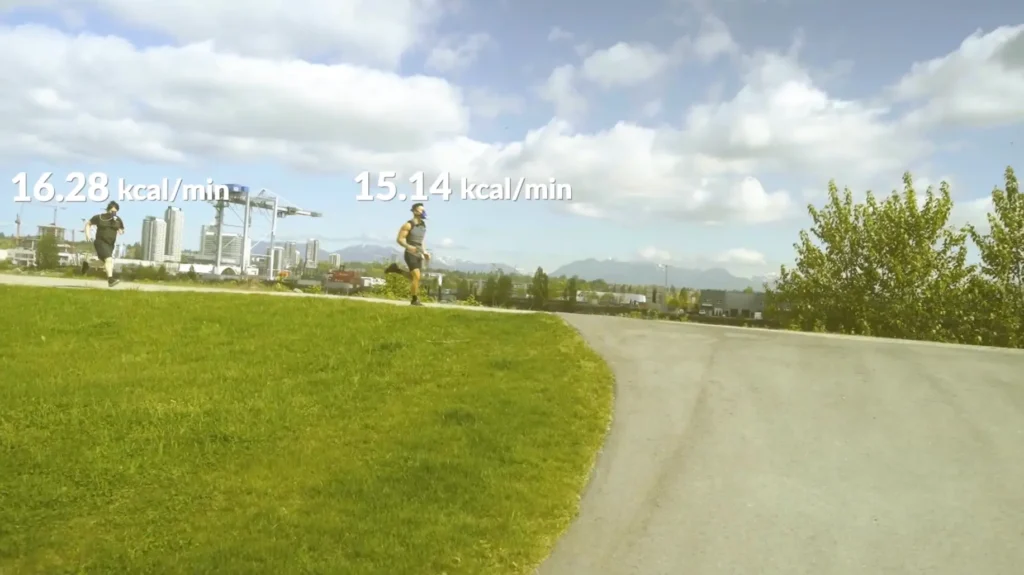
With burpees a close second with:
- 12.56 calories burned/min (me)
- 12.59 calories burned/min (Kevin)
But so far all three challenges had put us through the ringer.
And what I’m hoping to find with this challenge are exercises that can burn a high level of calories with a significantly lower perceived exertion, if we can find exercise that land in that sweet spot, then you can burn an insane amount of calorie without feeling like you’re going to pass out.
And fortunately we still have 47 exercises left to test.
Assault Bike
The data showed for each high intensity exercise we were absolutely burning through our calories even for just a 60 second workout, but so far every high calorie burning workout we tried also had an equally high perceived exertion.
And if Kevin was looking for a workout that can burn insane calories while sitting down, then I was sure I had found him the perfect exercises.
The Assault bike.
I promised Kevin $500 if he could beat my time. So, naturally, that got Kevin all excited, and he raced to the Assault Bike.
And while Kevin is working to take my money, I some of you make be wondering how these calorie masks actually work.
Basically, it measures the amount of oxygen used and carbon dioxide released during each breath, and combines this with our heart rate to determine the exact number of calories we’re burning.
However, our heart rate would spike after each exercise. So to avoid skewing the results, we made sure to wait until our heart rate stabilized back to baseline before starting the next exercise.
So how did our scores from the masks compare to the Assault bike?
It turns out Kevin and I burned only 13 and 12 calories respectively 2/3rds less than the assault bike estimated.
Which meant that, yes, Kevin beat me:
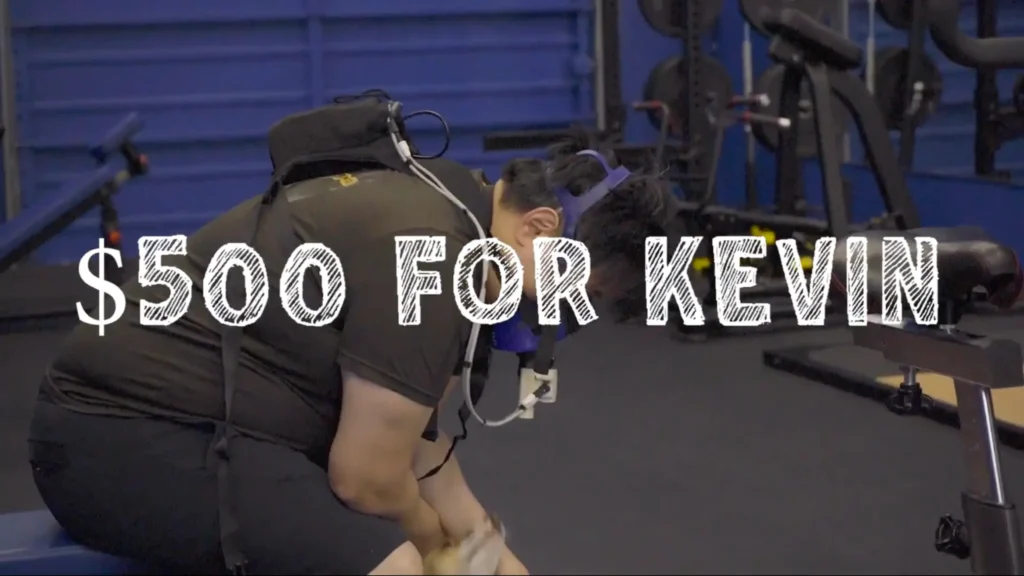
Calorie Burn Numbers On Cardio Machines Aren't Accurate
I asked Dr. Eric Helms why this is so, and this is what he said:
Cardio machines are really a bit of a black box.
There is some equation that goes in there that uses the body weight.
You enter maybe your age, maybe your height, depending upon what it asks, and then it spits something out.
I'm not sure if that's based on the equation from 1970 last year or some proprietary thing that the company created.
It's definitely not like a peer reviewed equation.
And it's certainly not going to be as accurate as gas exchange like you're measuring with the masks.
So I think you need to take the energy expenditure on a given machine with a big grain of salt.
The only time I would use, and the only way that I would use the energy expenditure on a cardio machine is if you're comparing a previous session on that same machine entering the same measurements as a relative difference.
So if you burned 30 on that machine last time and this time you burned 60, you probably did about twice as much work.
I would have some reasonable confidence in that it should be a fixed equation, but beyond that, I wouldn't put much stock into those values.
Kevin Was Exhausted
But when I checked back in on Kevin for the subsequent fat loss exercises, I realized we had a problem.
Kevin: I gotta tap out on that.
Jeremy: You’re gonna tap out?
Jeremy: What do you hate about it?
Kevin: I want some kind of rest, so my quads aren’t cramping.
It turned out that even though I had tried to select the best fat loss exercises, nearly all so far were leaving Kevin absolutely exhausted and that’s no way to sustain a program.
Which means we were gonna need to find a new approach. Find the best fat loss exercises, but low-intensity style.
Low-Intensity Fat Loss Exercises
Incline Walking
First up, incline walking.
We started with 3 miles per hour at a 2 incline, which burned around 6 calories per minute (5.7).
Bumping the speed up to 3.5 and the incline up to 6 led to a pretty impressive 30% jump in calorie burn (up to 7.44).
But you know how people at the gym tend to lean on the cardio machines or hold onto the rails when incline walking?
Yeah so we tested that next.
And it dropped the calorie burn by 20% (down to 6 calories per minute), which aligns with the findings of a 2014 study that tested the exact same thing.
Dr. Eric Helms shares why this happens:
You're essentially reducing your body weight so that you don't have to move as much of it on the treadmill.
So if you're on a treadmill and you're not holding on at all, then you have to propel your whole mass.
But if you are leaning on the treadmill unloading some of your mass, then you're basically only walking with a part of your body is where does that sound and therefore burning fewer calories.
But what’s true of all of our walking, was that Kevin was able to get through it without feeling like he was going to collapse, which meant the switch to low intensity fat loss exercises was definitely the right direction.
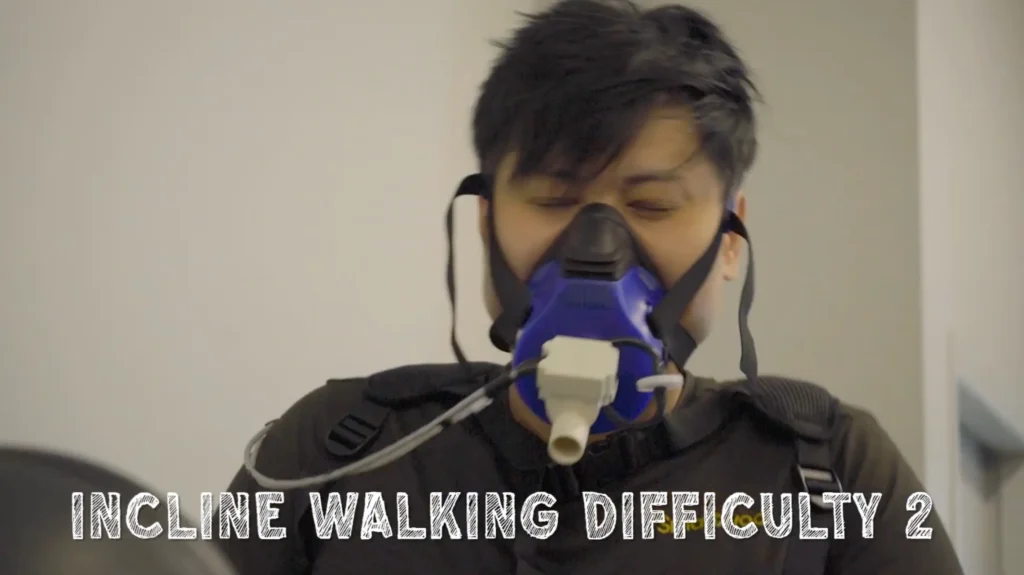
Other Low-Intensity Fat Loss Exercises
Longboarding, an activity I loved doing as a kid, was “winning” in my calorie battle for low intensity fat loss exercises, burning an impressive 11 calories per minute.
Beating the elliptical, stairmaster, and other forms of cardio that I just don’t really enjoy.
And although Kevin didn’t feel comfortable hopping on the board, basketball was working out really well for him, and it looked like he was having fun doing it.
But Are Low-Intensity Fat Loss Exercises As Effective?
Dr. Eric Helms weighs in:
There's a recent systematic review and met analysis that came out at the end of 2021 titled Slow and Steady or Hard and Fast.
The researchers specifically found that there didn't seem to be any difference between interval training and moderate-intensity continuous training when it came to changes in body composition.
So the true advantage of high intensity work is just that you can get it done faster.
It's mostly useful from a perspective of how much time do I have to allocate to training and then what's the biggest point of friction or barrier to successful adherence long term?
Is it the perceived difficulty of the training?
If that's the case, then you probably don't want to do really high intensity demanding fatiguing exercise or is it the time component, but you're okay with maybe putting forth a little more effort with a limited time.
At this stage, I was curious about EPOC, so I asked Dr. Eric Helms to dive deeper into that:
For those who don't know, EPOC, or excess post-exercise oxygen consumption, is the post-exercise elevated metabolism that comes from essentially the recovery process from doing really high intensity exercise.
And it's a real thing, don't get me wrong. It's actually been measured.
But when it actually comes down to, "Does it seem to provide an advantage so that you're actually losing more body fat over time?"
The answer unfortunately is no. Or that it's so minuscule that it's not detectable by the technology we have currently.
And ultimately when we measure body fat changes long-term, when we compare head to head interval training versus continuous training, we don't see any differences.
Dr. Eric Helms shares a few tips on how someone would choose between low-intensity and high-intensity fat loss exercises:
When you're training at a higher intensity, it generally is a more skilled movement having to manage higher speeds and higher forces.
So it's generally not advisable just from a movement quality perspective for a complete novice to do an exercise at a high intensity, but other movements that's not necessarily the case.
If you're doing burpees, if you're doing sprints, if you're doing jumps, if you're doing battle ropes, if you're doing kettlebells, if you're doing all of these kind of blended resistance training, pseudo metcon cardio exercises that are even more skillful, those are ones that you probably want to reserve until you've developed a certain level of movement skill before you get into them.
So if someone has a decent training history like you talked about, and they can handle high intensity activity, it's on the table.
The next question is do they enjoy it?
Because some people really do like to feel that sensation of pushing themselves.
They want to sweat, they want to be exerted, and doing just casual cardio and getting steps or doing something continuous feels boring.
So I think the first thing you want to do is establish do you have the fitness level that high intensity training is on the table? If yes, do you enjoy it? Great.
If you enjoy it equally to a moderate intensity, then you can choose when you want to do it based upon your time availability.
If you don't enjoy it, don't do it unless you really are time constrained.
And then it's kind of like, oh, well maybe I got to hold my nose and take the medicine because I just can't get enough of a calorie burn in the limited time availability that I have. But for me, it always comes down to what's practical, what's sustainable, and do they have the fitness level?
Bottom line? My takeaway was that high-intensity and low-intensity fat loss exercises are equally as effective so it depends on what you’re comfortable with and would be consistent with.
Strength Training
We even moved into strength training to find out if this was a better calorie burning option than cardio.
Surprisingly, unless the weights got really heavy, strength training was burning significantly less calories than most of the cardio exercises we tested. Not to mention we could just barely make it to a minute on most exercises before we couldn’t do anymore reps.
Strength Training Is Not A Great Tool For Fat Loss, But ...
Here's what Dr. Eric Helms had to say:
Strength training is even higher intensity than many forms of high intensity cardio.
It's so high intensity that instead of going, all right, I'm going to go a minute on, two minute off, like you might with cardio, you're typically doing five to 12 reps, which is going to take less than a minute.
That's typically going to be completed in 20 to 30 seconds.
And if you're training to failure, then you may need to rest one, two or three minutes before you can then perform at your best afterwards.
So, essentially, you're spending more time resting during a weight training workout than you are actually lifting weights.
The total energy expenditure won't be that low, but it's certainly not the most efficient form of burning calories.
Weight training is great for maintaining muscle mass and ensuring that the weight you lose is primarily body fat, but it's not a great tool for fat loss itself.
If you were to take one person who lost 10 pounds, but they were doing zero weight training and you took another person who lost seven pounds, only 70% of the weight loss of the other person, but they were doing weight training, I would bet my money that the amount of actual fat loss and more importantly the aesthetic changes would be better in the person who only lost seven pounds,
Takeaway? Don't lift weights for the sake of trying to burn as many calories as possible.
Lift weights because it tells your body to keep and even build more muscle as you're losing fat, which ultimately is like most people's goal when they're trying to transform their body.
Now I get how overwhelming this might all seem to you right now.
What exercises should you do and how often? What about your diet?
Well, the results I’ll reveal later on will help provide some answers.
But my team and I have also created an all-in-one, step-by-step program that takes care of all the guesswork for you and tells you exactly how to train and what to eat week after week to get into the best shape of your life. If you’re interested, take our free quiz to find the best plan for you and your body below:
Click the button below to take my analysis quiz to discover the best program for you:
↓
Ab Exercises
But for now, let’s talk about the ab exercises we tested.
We also tested abs exercises like crunches, which ended up burning the fewest calories of all the exercises we’ve tested so far (3.44 calories/minute). At this rate, you’d have to do 17 hours worth of crunches to burn the calorie equivalent of 1 lb of fat.
But, despite the low scores from our workouts, our date from our first day showed Kevin and I had burned 800 calories across the entire course of our testing, and I felt like I was well on my way to building a perfect workout plan packed full of the best fat loss exercises to help Kevin.
Then, something Dr. Eric Helms said gave me a lightbulb moment:
I think an important perspective [for someone wanting to lose weight] is that if they go in and they absolutely crush it with say a bunch of interval work, met cons for 45 minutes three times per week, the impact of that will be a whole lot less than if they say went from having three to 4,000 steps per day to getting seven to 9,000 steps per day.
I think a far better way to think about this is how do I re-engineer my life such that I'm not trying, but I'm being more active?
The latter would have a far greater impact on their total daily energy expenditure rather than trying to figure out what's the way that I can burn the most possible calories in a discrete time window.
At this point, I realized just trying to build an optimized workout plan for Kevin wasn’t going to be enough.
I needed to find a way to test how we burn calories in all areas of our life, and as I started researching, I found even more claims I still hadn’t tested, which meant I only had one choice.
Leisure Time/Chores
That means testing every chore and activity you can do with your free time whether it’s vacuuming, reading, or folding the laundry.
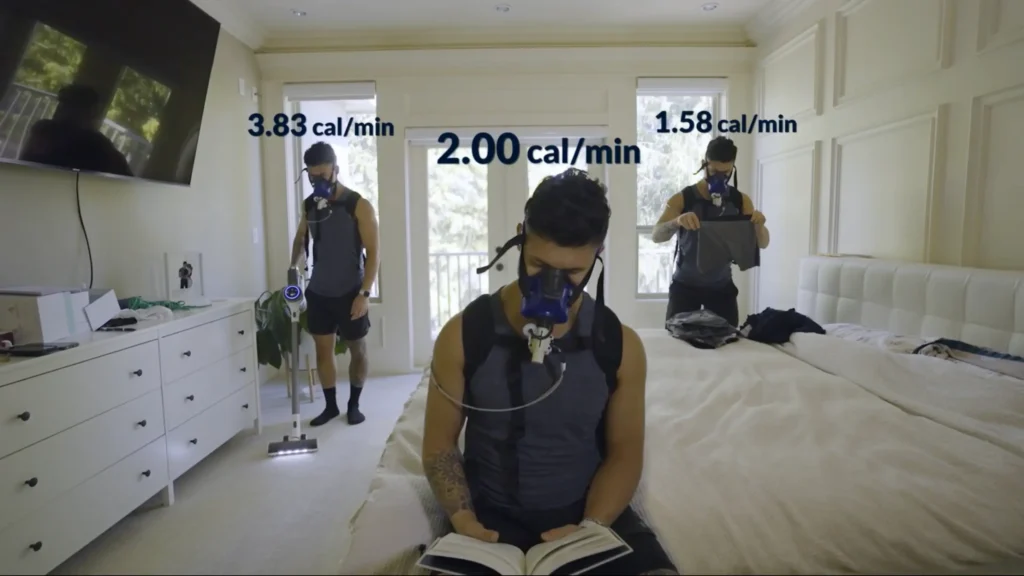
Also ...
Standing
Standing. Just simply standing.
As for Kevin, he was going through the same circuit of tests downstairs testing average calories burned standing, sitting, sitting while fidgeting and moving around, and sitting while playing a video game.
Turns out, video games burned slightly more calories than just sitting.
Standing burned even more calories, but sitting while fidgeting burned the most! Now, I don’t think fidgeting all day is a healthy obsession to develop, but one 2018 study did investigate standing.
They had office workers replace 1 hour of sitting with 1 hour of standing.
After 3 months, the extra standing was associated with almost 1 lb of fat loss (0.7 lbs) and a 0.32 cm decrease in waist circumference.
As for video games and fat loss, I wouldn’t put my money on it.
Housework
Now, not only was I earning BoyFriend of the year award by taking care of all the housework, I was finally starting to build a clear picture of all the ways you can maximize calorie burn through the course of the day.
For example, walking outside burned an impressive 6 calories per minute for Kevin.
Although that’s almost 1/3rd of what he burned doing sprints, I’m pretty sure he’d much rather go for a 30 minute walk than suffer through 10 minutes of sprints.
There was only one topic left to investigate, and that was all the exercises I found online that claimed to burn a shocking number of calories or what I’m gonna call the Super Burning exercises, beginning first with Boxing, Power Walking and Med Ball slams.
What About Chess?
Okay so I can’t actually play chess, but to test this claim Kevin and I will be playing a game of high stakes checkers. And it’s high stakes because if Kevin beats me, I’ve promised him a $1000 bonus.
So I don’t want to lose.
As for the calorie burn?
I first asked Dr. Eric Helms to weigh in:
I have no doubt that being intensely intellectually active burns more calories than say just chilling.
You probably burn more calories playing chess than listening to Joe Rogan.
I'm sure the first is a lot more intellectually challenging and stimulating, or at least it should be, but I don't think it's probably as high as 6,000 calories a day if I had to guess.
Well, turns out, he was spot on.
Although my brain probably wasn’t working quite as hard as a master chess player, it didn’t burn nearly as much as I anticipated. 2.2 calories per minute, just a touch higher than sitting.
Which Were The Best Fat Loss Exercises?
Anyways, now that I have all the data, it’s time to reveal the best fat loss exercises and create the ultimate fat loss routine.
By the way, here's the link to download the calorie burn data for all 50 tested fat loss exercises.
Kevin and I actually had the same top three best fat loss exercises.
Sprinting, Boxing and the Devil’s Press burned more calories than any other exercise.
And although sprints, when averaged out between us, came out as #1, boxing was the one exercise we enjoyed the most and could actually see ourselves sticking with long term.
Now what about low effort fat loss exercises that still burn a decent amount of calories?
Well, longboarding, basketball, incline walking, and even just plain old walking outside were our top picks.
And as for high effort fat loss exercises that didn’t end up burning very many calories, Kevin and I both agreed that Power Walking topped that list.
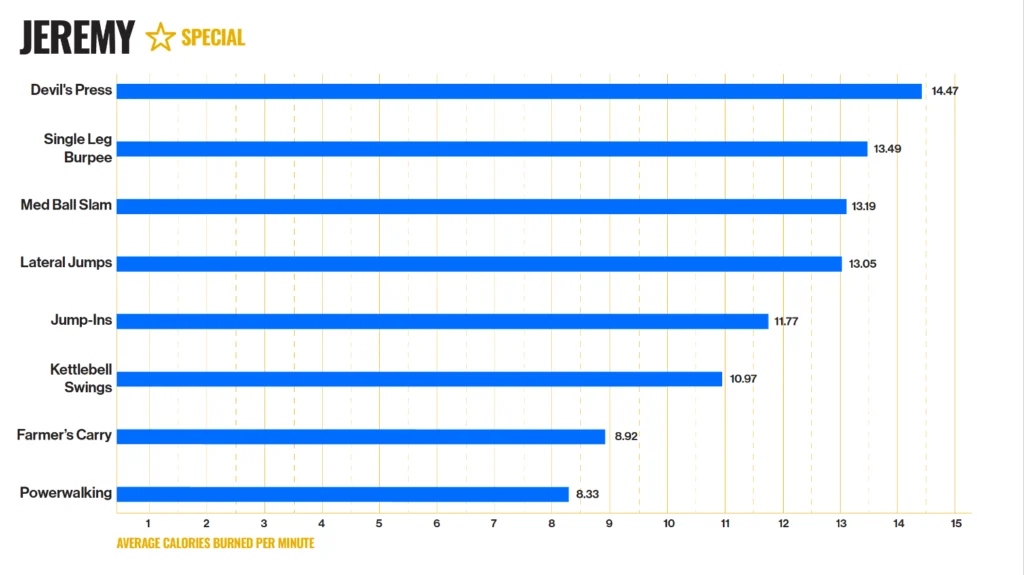
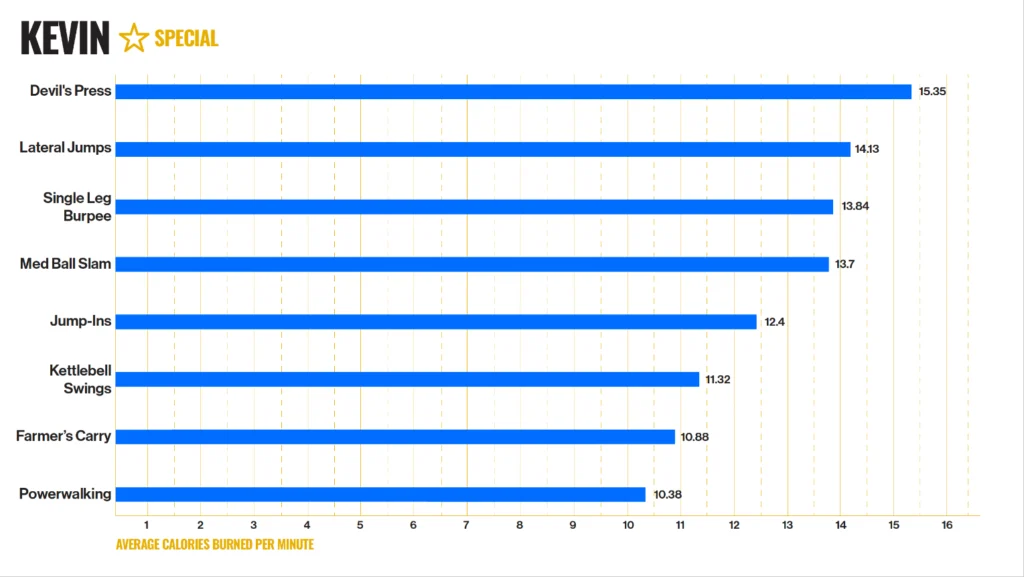
But jumping jacks, planks, crunches, and as you learned most strength exercises, also burned a surprisingly low amount of calories relative to their effort.
But while it’s easy to assume the exercise that burns the most calories must be the best, my experience with Kevin has shown me it just isn’t that simple.
Dr. Eric Helms sums it up perfectly:
I don't think we should be thinking of it as a tier list of which exercise burns the most calories.
I think really what we will want to think about is energy expenditure over time that I will adhere to.
What you really want to think about is all of these different fat loss exercises and intensities as tools and you want to have a robust tool belt. The whole variety in your tool belt is going to make it far more likely that you could adhere to exercise long-term and get the fat loss that you're after.
TL;DR
- High-intensity fat loss exercises are the most efficient at burning calories, but they’re very tough and likely unsustainable for most.
- Low-intensity fat loss exercises are typically more enjoyable. Thankfully, research shows they’re equally as effective as high-intensity exercises in stimulating fat loss.
- Choosing between high-intensity and low-intensity exercises comes down to 1) skill level, 2) personal preference, and 3) time availability.
- Strength training isn’t the best way to burn calories, but it tells your body to keep and build muscle while you’re losing fat.
- A better way to approach fat loss is to think about how you could re-engineer your life such that you’re more active without trying (instead of “spamming” exercises).
What's Next?
But guys, so far, all we’ve talked about is fat loss exercises, i.e., exercise.
And to succeed in your fat loss journey you can’t just focus on training and neglect your nutrition.
In fact, I put this to the test by measuring how long it actually takes to burn off a McDonald’s meal. What we found will blow your mind and you can check out that article next here.
Thanks for sticking to the end, and I’ll see you next time!

